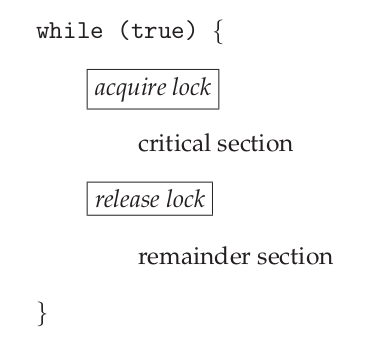Mutex Locks
Operating-system designers build higher-level software tools to solve the critical-section problem. The simplest of these tools is the mutex lock.
Mutex is short for mutual exclusion.
We use the mutex lock to protect critical sections and thus prevent race conditions. A process must acquire the lock before entering a critical section and release the lock when it exits the critical section.

POSIX API
pthread_mutex_init()
int pthread_mutex_init(pthread_mutex_t *mutex, const pthread_mutexattr_t *attr);
This creates an object of type mutex with attr attributes (for default, use NULL).
Put the variable in a zone where all threads can see it.
pthread_mutex_(un)lock()
A mutex can be either locked or unlocked.
When the mutex is locked, a thread holds the control of the critical section until he gives up.
The critical section must be delimited by the functions:
pthread_mutex_lock(&mtx);
/* critical section */
pthread_mutex_unlock(&mtx);
When we don't need the object anymore, we delete it using pthread_mutex_destroy(pthread_mutex_t *mutex).